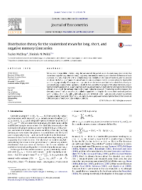
An official website of the United States government
Here’s how you know
Official websites use .gov
A .gov website belongs to an official government organization in the United States.
Secure .gov websites use HTTPS
A lock (
) or https:// means you’ve safely connected to the .gov website. Share sensitive information only on official, secure websites.
-
//
- Census.gov /
- Library /
- Census Working Papers /
- Distribution Theory for the Studentized Mean
Distribution Theory for the Studentized Mean for Long, Short, and Negative Memory Time Series
Distribution Theory for the Studentized Mean for Long, Short, and Negative Memory Time Series
Abstract
We consider the problem of estimating the variance of the partial sums of a stationary time series that has either long memory, short memory, negative/intermediate memory, or is the first-difference of such a process. The rate of growth of this variance depends crucially on the type of memory, and we present results on the behavior of tapered sums of sample autocovariances in this context when the bandwidth vanishes asymptotically. We also present asymptotic results for the case that the bandwidth is a fixed proportion of sample size, extending known results to the case of flat-top tapers. We adopt the fixed proportion bandwidth perspective in our empirical section, presenting two methods for estimating the limiting critical values—both the subsampling method and a plug-in approach. Simulation studies compare the size and power of both approaches as applied to hypothesis testing for the mean. Both methods perform well – although the subsampling method appears to be better sized – and provide a viable framework for conducting inference for the mean. In summary, we supply a unified asymptotic theory that covers all different types of memory under a single umbrella.
Others in Series
Working Paper
Working Paper
Working Paper
Share
Related Information
Some content on this site is available in several different electronic formats. Some of the files may require a plug-in or additional software to view.
 Yes
Yes
 No
NoComments or suggestions?


Top

